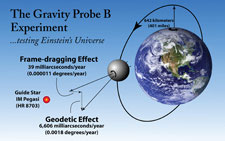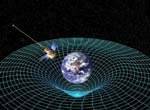WEEKLY HIGHLIGHTS FOR 3 DECEMBER 2004:
GRAVITY PROBE B MISSION UPDATE

On mission day #227, the GP-B spacecraft continues to be in good health, with all subsystems performing well. As of tomorrow, we will have been collecting relativity data for 100 days. The data collection process is proceeding smoothly, and the quality of the data remains excellent. All four gyros are digitally suspended in science mode, and the spacecraft is flying drag-free around gyro #3, maintaining a constant roll rate of 0.7742 rpm (77.5 seconds per revolution.) The temperature inside the Dewar is holding steady at just under 1.82 kelvin.
It has been relatively quiet here in the GP-B Mission Operations Center, since the strong solar flares and geomagnetic storm three weeks ago. Our team continues to adjust the flow rate of the excess helium from the Dewar during the present a 6-week “hot” season, where the spacecraft is continually in sunlight throughout each orbit. (See last week’s highlights for a discussion of the spacecraft’s seasons.)
 Furthermore, seasonal warming of the spacecraft has resulted in the Attitude Reference Platform (ARP) on the outside of the spacecraft producing data that slightly diminishes the pointing accuracy of the Attitude and Translation Contro system (ATC). To address this issue, the ATC team installed a modified data filter, and tests performed this past week indicate that spacecraft pointing accuracy has now improved.
Furthermore, seasonal warming of the spacecraft has resulted in the Attitude Reference Platform (ARP) on the outside of the spacecraft producing data that slightly diminishes the pointing accuracy of the Attitude and Translation Contro system (ATC). To address this issue, the ATC team installed a modified data filter, and tests performed this past week indicate that spacecraft pointing accuracy has now improved.
Finally, the team has been adjusting controls on the navigational gyroscopes that are used by the ATC to keep the telescope pointed towards the guide star, IM Pegasi (HR 8703), during periods when the spacecraft moves behind the Earth, eclipsing the telescope’s view of the guide star. These adjustments have reduced the time required for the telescope to re-lock onto the guide star--when the spacecraft emerges over the North Pole--to less than one minute.
One nice side effect of being in a 6-week “hot” season is that the sunlight shining broadside on the spacecraft makes it more prominent to see from various locations on Earth in clear skies. The spacecraft is best viewed at times when it passes nearly overhead to your location, in the pre-dawn or evening twilight sky. A typical GP-B pass lasts about 15 minutes from horizon to horizon. From a viewing location that is devoid of city lights, you can see the GP-B spacecraft with your naked eye; in locations with more ambient light, binoculars may be helpful. See the links in our GP-B FAQ to view satellite tracking Web pages for computers and PDAs (Palm Pilot, Blackberry, and so on).
THE EINSTEIN EXHIBITION AT THE SKIRBALL CULTRAL CENTER IN LOS ANGELES
 If you're going to be in Los Angeles anytime before 30 May 2005, and if you’re interested in Einstein’s life and work, the Einstein Exhibition at the Skirball Cultural Center (just north of the Getty Museum on Interstate 405) is the most comprehensive presentation ever mounted on the life and theories of Albert Einstein (1879-1955). It explores his legacy not only as a scientific genius who re-configured our concepts of space and time, but also as a complex man engaged in the social and political issues of his era. It examines the phenomenon of his fame and his enduring status as a global icon whose likeness has become virtually synonymous with genius.
If you're going to be in Los Angeles anytime before 30 May 2005, and if you’re interested in Einstein’s life and work, the Einstein Exhibition at the Skirball Cultural Center (just north of the Getty Museum on Interstate 405) is the most comprehensive presentation ever mounted on the life and theories of Albert Einstein (1879-1955). It explores his legacy not only as a scientific genius who re-configured our concepts of space and time, but also as a complex man engaged in the social and political issues of his era. It examines the phenomenon of his fame and his enduring status as a global icon whose likeness has become virtually synonymous with genius.
In this exhibit, you can examine Einstein's report card, inspect his FBI file, and enjoy his family photographs, love letters, and diary entries. Exhibition highlights include scientific manuscripts and original correspondence—including original handwritten pages from the 1912 manuscripts of the special theory of relativity and his 1939 letter to President Roosevelt about nuclear power—and a wealth of other documents from the Albert Einstein Archives at the Hebrew University of Jerusalem.



In addition to these displays of Einstein memorabilia, the exhibit also features a number of interactive components that help provide an understanding of Einstein's revolutionary theories. Furthermore, several “explainers,” identified by their red aprons, are on hand to discuss various aspects of the exhibit and to explain and demonstrate difficult concepts, such as time dilation and warped spacetime. At the end of the exhibit, you’ll find one of GP-B’s gyro rotors on display.
The Einstein exhibition was jointly organized by the American Museum of Natural History (AMNH), the Hebrew University of Jerusalem, and the Skirball Cultural Center. It was designed by the AMNH under the supervision of Dr. Michael Shara, curator of the exhibit and chairman of the museum’s Astrophysics Department. It opened in November 2002 at the AMNH in New York and then traveled to Chicago and Boston, spending about 8 months in each location. It will remain at its final U.S. stop at the Skirball Center in Los Angeles through 29 May 2005, after which time it will move permanently to the Hebrew University in Jerusalem.
Information about the Einstein exhibition is available on the Skirball Center Web site. If you can’t make it to Los Angeles, you can visit the AMNH’s virtual Einstein exhibit on the Web.
Drawings & photos: The diagrams of the GP-B experiment are from the GP-B Image Archives here at Stanford. The photos from the Einstein Exhibit are courtesy of the Skirball Cultural Center. Click on the thumbnails to view these images at full size.
Please Note: Until further notice, we intend to continue posting these GP-B highlights on a weekly basis. Also, from time to time, we may post special reports and special updates, as warranted by mission events.
More links on recent topics
- Track the satellite in the sky
- Photo, video & and news links
- Build a paper model of the GP-B Spacecraft
- Following the mission online
- Our mailing list - receive the weekly highlights via email
- The GP-B Launch Companion in Adobe Acrobat PDF format. Please note: this file is 1.6 MB, so it may take awhile to download if you have a slow Internet connection.
Previous Highlight
Index of Highlights
